It seemed the development of Dadiba village had no solution, but the past years proves another story.
Dadiba means "big land," but the biggest flat land in the village is only the same size as half a soccer pitch.
It is filled with countless pyramid-shape mountains in Ziyun county, southern Guizhou of Southwest China. It is not very high, but steep and slippery, covered with greenery, impossible to climb, let alone farming.
Black stones scatter on the limited pieces of flat arable land. Many machines are useless here.
A valley that is cloudy and foggy almost of all year-round suffers a severe shortage of water due to the fragile Karst landform.
At least 600 years ago, the Miao people, who might have escaped from wars to take refuge in the mountains, moved to this unknown land.
It is not a surprise that Dadiba is one of the least developed places in Guizhou. It was not connected to the power grid until December 2007, making it the last village that had electricity in Guizhou.
"When I first visited here 12 years ago, the 14-kilometer road from town entering the village took me almost two hours," Lu Kai, who works in the publicity department of Ziyun, told the Global Times. "The road was too bad in condition, and unsafe to drive."
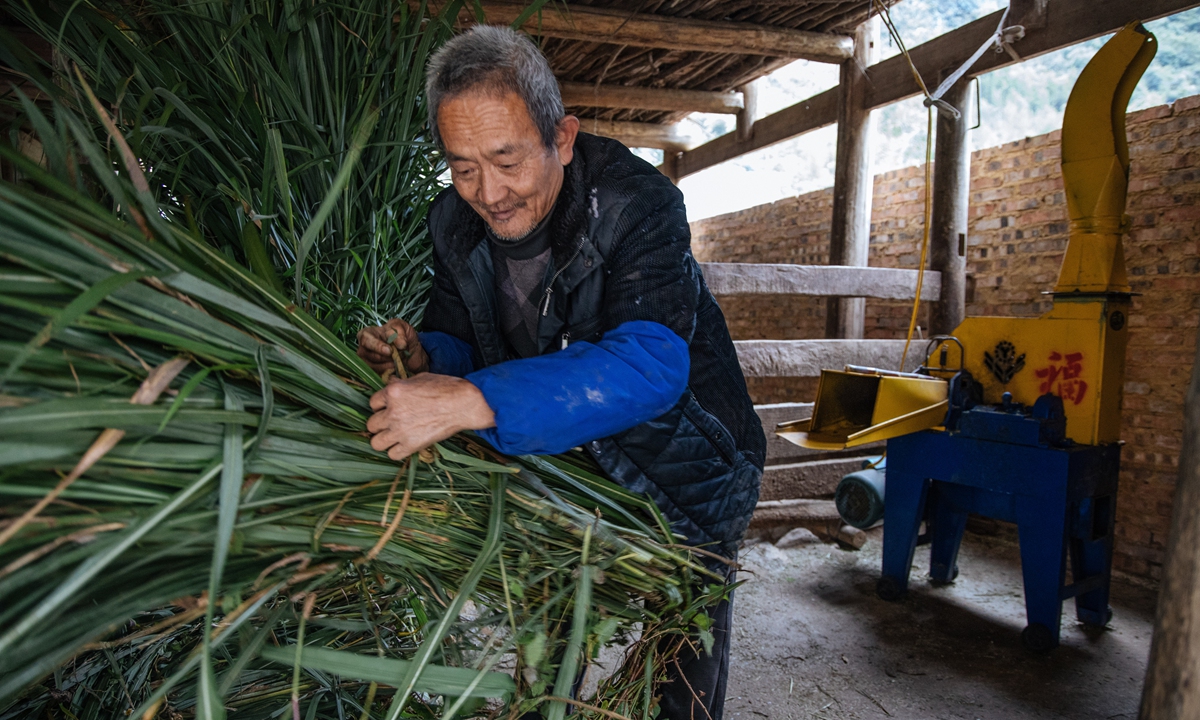
Zhu Changfu, a villager at Dadiba village, prepares feed to his cattles. He makes 35,000 yuan only by selling cattles and pigs every year. His family has shaken off poverty in 2018. Photo: Li Hao/GT
Among Ziyun's 120,500 residents, 117,638 were registered poverty-stricken population, according to a county statement sent to the Global Times.
But how could villages like Dadiba shake off poverty?
China launched a campaign to eliminate absolute poverty by 2020. Dadiba received aid from regional governments, while Ziyun and Guizhou received supports from the central government.
A "combat team" for poverty relief staioned in Dadiba with members from county-level governmental departments. In Ziyun, more than 6,000, or 70 percent of officials and civil servants working in county governmental departments were dispatched to villages for similar work.
The changes have been quite apparent, especially in the past year.
The first step was to build a proper road. The project was finished 2014, when a new flat neat road, circled by the mountains, was completed to connect Dadiba and the nearby towns.
Then "combat team" introduced chayote, pubescens and Rosa roxburghii as economic products. Funding is given out to poor families to raise pigs and cows.
Two doctors are also in the village clinic and consistently visit the families. The government installed water filters for each family, providing access to clean water.
New safe houses have been built to replace the fragile inadequate housing. Villagers now have household electrical appliances such as refrigerators and televisions.
After six years of the poverty reduction campaign, all households had shaken off poverty in the village in October 2020.
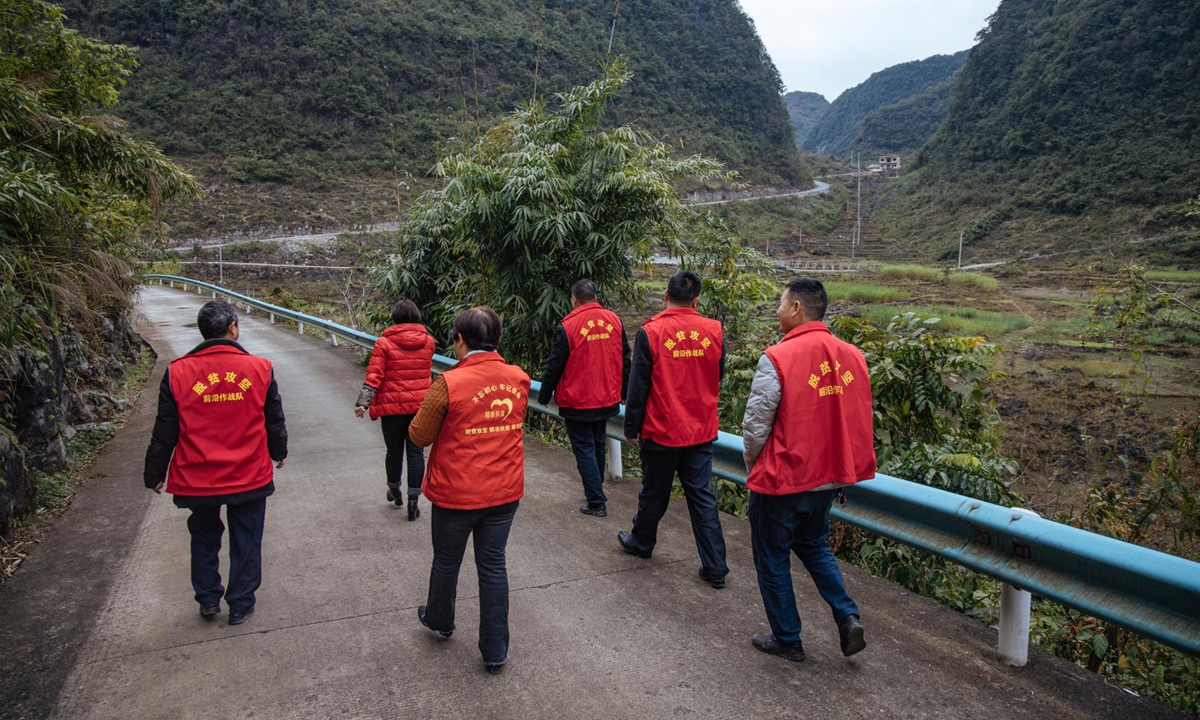
The "combat team" of poverty alleviation in Dadiba village Photo: Li Hao/GT
"I want our children in the village to watch Boonie Bears cartoon, just like the children in cities," Wang Chaosi, first Party chief and the captain of the combat team in Dadiba, told the Global Times. "It's all worth it."
Zhu Changfu, 67, bought the first television for his family, a digital one with a Samsung screen. By raising cattle, he could earn at least 6,000 yuan a year. His son and daughter-in-law now found a job in South China's Guangdong Province.
Next year, his two young grandsons could go to the new kindergarten and primary school that is under construction right now besides the village committee.
"Our life is better," Zhu told the Global Times. "We are really grateful."
"I can hardly see if the achievement of Dadiba's change could be copied in another country," Lu said, while driving in the new road entering Dadiba.
On November 23, Ziyun Buyi and Miao autonomous county officially announced the eradication of extreme poverty along with eight other counties in Guizhou. These are China's last nine counties that eliminated absolute poverty.
Third-party evaluations showed that overall incidence of poverty in the nine counties in Guizhou had been reduced to zero percent, and the satisfaction rate among residents was over 99 percent, said Li Jian, director of the provincial poverty alleviation and development office, at a press briefing.
The average annual net income of impoverished people in these nine counties has risen to 11,487 yuan ($1,740), well above the 4,000-yuan national poverty line set this year, Li said.
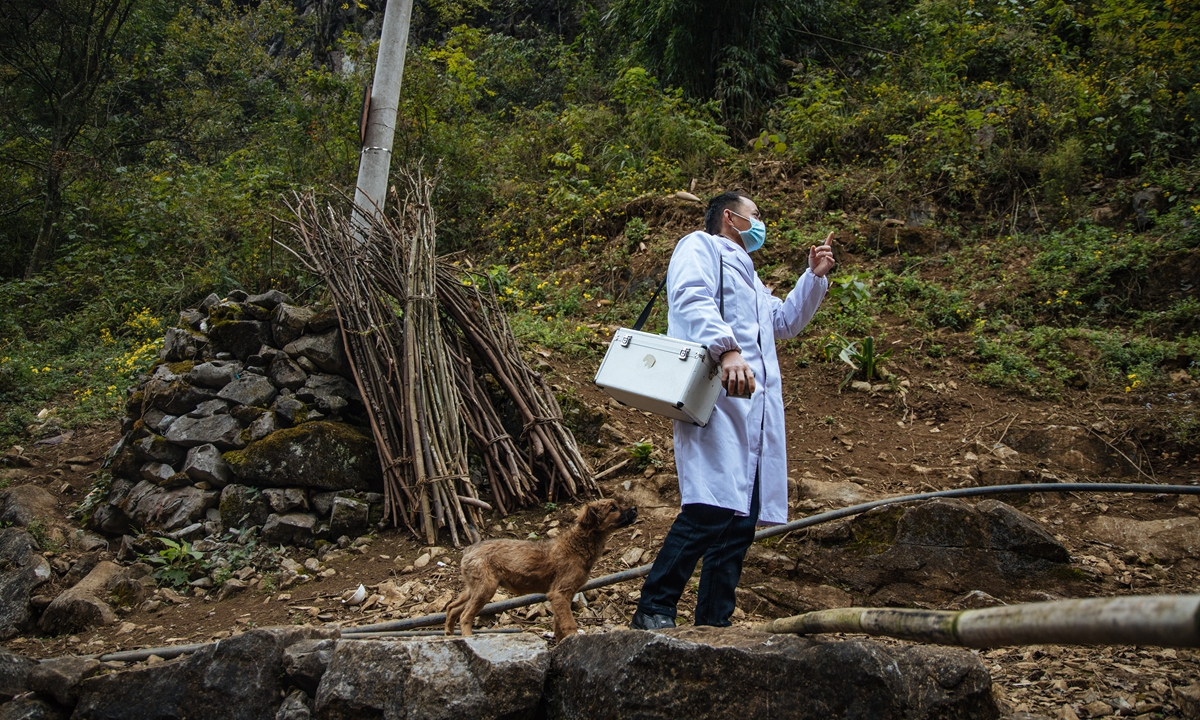
Yang Xiaofang, the doctor of Dadiba visits a villager Photo: Li Hao/GT
In Ziyun, over the past few years, more than 4,862 households involving 20,213 people who lived in poverty have been relocated in the county as part of China's poverty reduction campaign. They moved to new apartments in town from their old houses that were either dilapidated or in remote mountains or both.
The government provided the apartments equipped with tidy public areas, fountains, clean drinking water and charging ports for electronic bikes.
To provide employment for those who were relocated to have better living conditions but still under the poverty line, Ziyun county launched the "commuting farmers" project, arranging work for them on farms that produce famous "red-heart" sweet potatoes and other economic products.
Ziyun was finally able to shake off poverty thanks to the guidance and help from all aspects, from the central governments to the society, Yu Wei, director at the poverty alleviation office in Ziyun, told the Global Times.
"But we shall not celebrate," he said. "Next we still have much work to do to consolidate and expand the work of poverty reduction."
With years of battles against poverty, all 832 registered poor counties in China have shaken off poverty as of November 23. The last nine impoverished counties, all in Southwest China's Guizhou Province, have passed the assessment conducted by third-party agencies.
This indicates that China has achieved the historical feat of getting ride of extreme poverty.
In 2012, the State Council Leading Group Office of Poverty Alleviation and Development published the first list of poverty-stricken counties. Targeted poverty alleviation efforts have since then been conducted in reducing poverty.
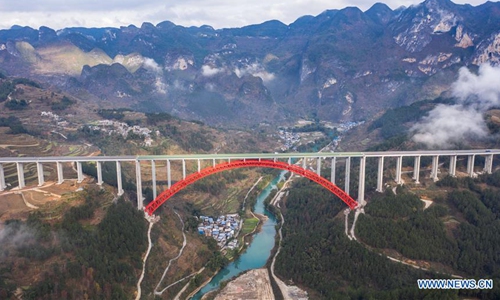
Aerial photo taken on Dec. 30, 2019 shows a mega bridge of the Pingtang-Luodian Expressway in southwest China's Guizhou Province. Both the Ziyun-Wangmo and Pingtang-Luodian expressways in Guizhou Province opened to traffic on Tuesday, reducing travel time between Ziyun and Wangmo to 50 minutes and that between Pingtang and Luodian to an hour. The two expressways are expected to help boost tourism and improve the lives of local residents. Photo:Xinhua
Moreover, through the years, at least 2.9 million civil servants and state-owned company employees in urban regions have been dispatched to rural areas to help local poverty reduction work.
"Such a remarkable achievement is inseparable from China's system advantage," Yu Shaoxiang, chief research fellow with the Chinese Academy of Social Sciences, told the Global Times.
Over the past 40-plus years of reform and opening-up, more than 800 million people in China have been lifted out of poverty, contributing more than 70 percent of the global poverty reduction.
But it is not a stop mark of China's poverty alleviation work. Aid and policy support to less-developed regions will continue alongside assessments and inspections.
UN Secretary-General Antonio Guterres has spoken highly of China's success in poverty reduction, calling the achievements "very strong." China's experience can help more people in the world to improve their standard of living.
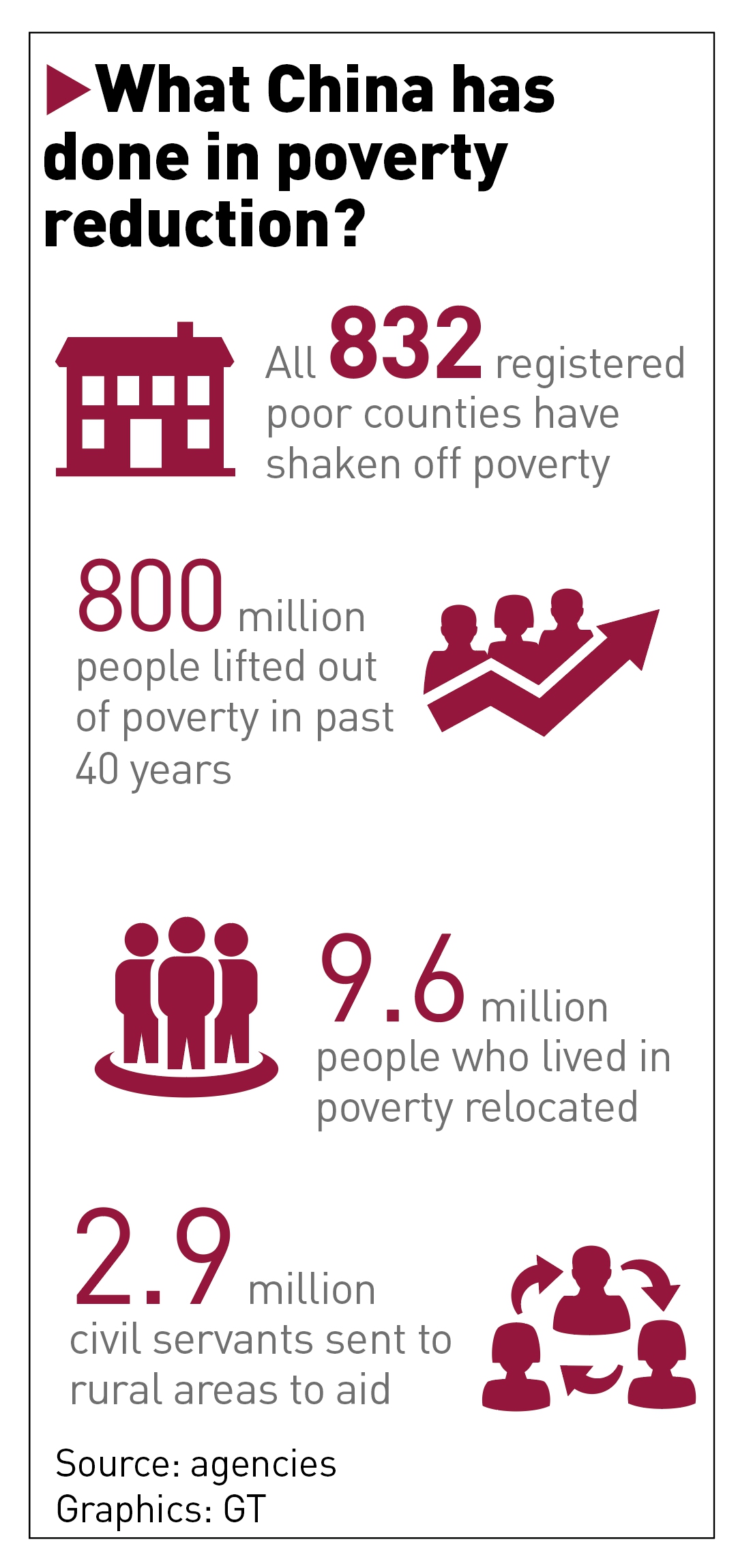
GT








